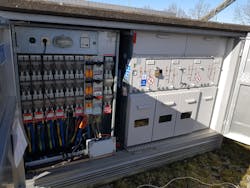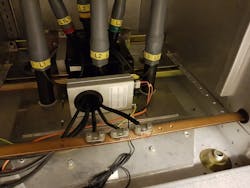The availability of digital technology enables changes to energy systems. With more customers becoming distributed electricity producers — generating their own power using technologies such as solar panels — the market structure is changing and could completely reverse in the coming decades.
Smart digital technologies are now used to control electricity generation, switching and billing. However, throughout the next decade, technology will need to expand further across the energy value chain to complete the transition. For example, accommodating an increase in distributed energy resources (DERs), transmission systems and distribution network power will require the ability to integrate these new technologies. Over the next five years, new and emerging technologies such as bifacial solar modules, small-scale biofuel solutions and battery storage technology will play a bigger role in the energy system. Simultaneously, these will increase the complexity of managing a reliable supply and the distribution of electrical energy.
As many future power systems will be governed by variable and intermittent generation from renewables, network operators will need to maintain and increase the security of supply and integrate low-carbon technologies. Digitalization will reduce the complexity and enable cost savings through smarter asset management and asset lifetime optimization as well as supporting the provision of flexible solutions in a distribution grid.
Smart Cable Management
Today’s networks operate safely at the highest possible capacity with margins applied to protect the underground cable infrastructure. Medium-voltage (MV) networks are designed with redundancies that, when combined with automated switching plans, ensures continuity of supply.
On-line and continuous cable monitoring systems are used to identify weak spots in the cable that ultimately could develop into permanent failure and damaging short-circuit currents. Application of advanced digital sensor technology enables network operators to reduce the capacity safety margin to accommodate the electricity demand, thereby avoiding unnecessary investments in capital-intensive network reinforcement.
Underground Cable Monitoring
The Smart Cable Guard (SCG) from DNV Netherlands B.V. is an example of a sensor-based digital cable monitoring platform that puts distribution utilities in complete control of their MV distribution network Through a combination of a patented two-sensor technology and a machine-learning algorithm with 24/7 support, the system can identify and pinpoint weak spots in an underground cable.
Weak spots are the result of small impurities, voids, manufacturing defects and damage to the underground cable’s insulation. High partial-discharge activity is a strong indicator of weak spots in an underground cable, but it is not easy to detect because it can be sporadic, change over time, and even disappear for days or weeks at a time. In contrast to off-line monitoring systems that can only provide snapshots of a cable’s health, the SCG system provides around-the-clock surveillance of partial-discharge activity, enabling the identification of all weak spots.
Occasionally, cable failures cannot be avoided. The SCG platform can pinpoint the location of the failure within the 1% of circuit length. This capability significantly reduces the time and effort required to locate and repair the fault, enabling the cable to be reenergized quickly and restoring the security of the distribution network.
Smart Cable Guard Platform
The DNV SCG platform comprises two sensor units and two control units, installed at each termination of the cable subject to monitoring. The system has the potential to monitor multiple cable sections up to a length of 6 miles (10 km) of cross-linked polyethylene (XLPE) insulated cable and 2.5 miles (4 km) of paper-insulated lead-covered (PILC) cable under typical noise conditions of the live MV cable. The system not only detects weak spots and faults within the cable’s circuit in the actual cable but also monitors all joints/splices and terminations.
The sensor units are enhanced high-frequency current transformers that detect and measure the change in the high-frequency pulses generated by partial discharges or faults. These sensor units inject pulses into the cable for time synchronization between the two sensors, which is required to accurately pinpoint the weak spot or fault. The control unit positioned at each termination processes the measured data and transfers it by a mobile or local ethernet connection to one of the cloud-based SCG control center for analysis and warning submission. The key challenge is to distinguish noise — for instance, high-frequency pulses from power electronics — from real partial discharges and faults from switching activities.
Over 20 years of research and practical application of the SCG platform globally has been used to train the algorithm to perform this analysis with greater than 99% accuracy. The algorithm uses about 20 parameters for distinguishing partial discharges from noise. Examples of these parameters include discharge intensity, variation in level, variation over time, variation because of temperature changes and cluster width. For distinguishing fault pulses from switching transients, the sensor units perform a real-time waveform analysis that identifies genuine fault pulses based on thousands of pulses detected and collected in the past.
If a weak spot or fault is detected, the network operator is notified within minutes with the precise location of the weak spot or fault. Plus, status updates are provided, identifying any partial-discharge activity. The alarms and analytical data are available and easy to access through DNV’s secure SCG web portal or can be integrated through an application programming interface (API) with the network operators’ asset management or asset operations’ IT systems.
Applying sensor-based digital technologies in a distribution network enables control center operators to increase power, manage congestion, reroute power flows as deemed necessary, and schedule maintenance procedures to repair or replace the underground cable without incurring a costly power outage.
Potential Applications
In 2022, DNV’s SCG solution surpassed a milestone of monitoring 3000 MV underground cables, with a total length of more than 4700 miles (7500 km) installed, voltage levels ranging from 3 kV to 69 kV, and both single-core (triplex) cables and three-core cables. With new and growing markets in North America and Australasia, the system is now active and available across the globe.
Some applications for this technology are as follows:
- Electricity distribution networks — These networks are becoming smarter, but they still are based largely on aging underground cable assets. The DNV SCG platform is a step toward digitalization and self-managed cable networks. It precisely locates weak spots and faults in underground cables and supports real-time decision making in power flows, network capacity management and maintenance. It can help to reduce customer minutes lost by optimizing proactive maintenance strategies through continuous and fact-based underground cable condition data. This continuous data enables distribution network operators (DNOs) to focus their investment and resources on underground cables in need of repair or replacement.
- Large industrial facilities — Facilities such as oil refineries, car manufacturers, chemical plants, data centers, and any other large users that depend on a reliable supply of electrical energy, benefit operationally and financially from an on-line underground cable monitoring system. Any interruptions in the supply of electricity can lead to production shutdowns and revenue loss. The SCG platform’s continuous 24/7 monitoring of feeder cables significantly improves efficiency and minimizes downtime.
- Onshore wind farms — As these wind farms become larger and more remote, individual turbines are connected into arrays to simplify the wind farm interconnection. As a result, a single feeder cable failure can have a significant impact on an entire array. The current methods of locating faults in feeder cables is relatively slow and expensive, whereas an on-line cable monitoring system’s continuous digital monitoring can significantly reduce the time and cost of locating and repairing cable failures. This enables wind farms to come back on-line faster, thus maximizing performance and profitability.
- Public transport systems — For mass train and metro rail systems, reliability is a key factor. A single cable failure can disrupt the entire network and leave passengers stranded, jeopardizing the reputation of the transit operator. DNV’s active digital power cable management system already helps to keep numerous rail systems running around the world. By pinpointing faults and weak spots in power supply cables, the platform enables rail operators to minimize the number and duration of service interruptions, ensuring the services’ reliability and keeping their trusted reputation intact.
Monitoring Benefits
The use of a digital cable monitoring platform such as SCG provides significant benefits to distribution network operators and large users of electricity operating their own grid, such as industries, wind farm operators and rail operators. Based on a variety of applications — small, medium and large scale — the installation of the sensor-based SCG system should be evaluated for each cable section in each substation. Typically, long cables with many joints/splices and a high load are the preferred candidates because their failure risk is above average and the impact of a failure is significant.
Financial benefits consist of lower operational repair costs, planning costs and outage penalties (regulation dependent). As a result, implementation of the SCG platform in a distribution network has proven to be financially beneficial. A recent cost-benefit analysis showed that the platform can even reduce outage time by 55%.
For large industrial users, the financial benefits are even more obvious. Any prevention of a failure will not only lead to reduction in operational repair and planning cost but also avoid a loss in production and revenue. In many cases where the system has been deployed on industrial complexes, the full return of the investment was achieved by avoiding just one failure.
Rethink Electricity Markets
Using digital monitoring platforms enables grid operators to focus resources where they are needed most, especially for critical infrastructure and large industrial users or producers. By replacing average lifetime statistics with de-averaged live digital monitoring, fact-based decisions can be made on which underground cables to repair or replace and when. Thanks to continuous real-time cable monitoring, unnecessary work and unpleasant surprises can be avoided. The Smart Cable Guard platform can save time and money, and mitigate evironmental impact.
Richard Denissen ([email protected]) has more than 25 years of experience in the energy industry, general management, projects and maintenance management. He worked for multinational companies in Europe, Asia, the U.S. and the Middle East before joining DNV Netherlands B.V. in 2016. Denissen is now responsible for the overall strategy, business development, sales and product development of Smart Cable Guard’s global business.
About the Author
Richard Denissen
Richard Denissen ([email protected]) has more than 25 years of experience in the energy industry, general management, projects and maintenance management. He worked for multinational companies in Europe, Asia, the U.S. and the Middle East before joining DNV Netherlands B.V. in 2016. Denissen is now responsible for the overall strategy, business development, sales and product development of the Smart Cable Guard global business.


